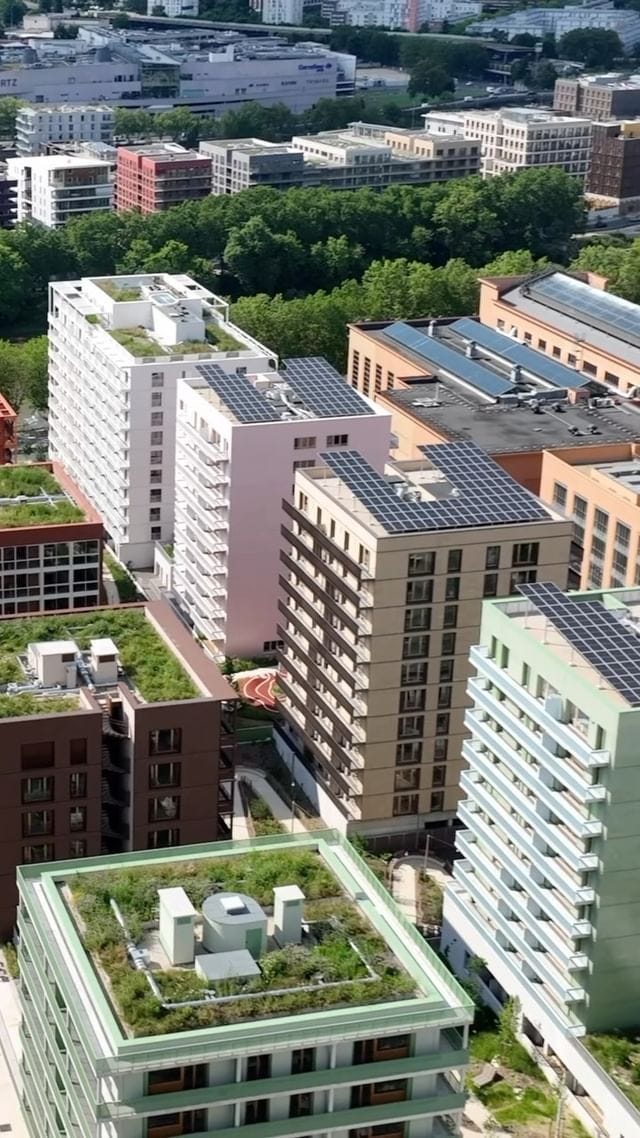Who among us also spent a solid four hours watching the opening ceremony of the Olympics? I, for one, found myself planted in front of my NBC livestream. I was ultimately disappointed that we did not get a face reveal of the masked torchbearer, and I loved the scene with the literary throuple, though I do fear that the creative direction abandoned far too many narrative threads for my liking. But altogether, I thought it was camp, and I had a great time.
In honor of that, I’ve got an Olympics-themed send for you, covering the artistry, architecture, and culture behind the biggest global sporting event.
Imagine a city. That is what the architects of the Paris Olympics have tried to do with its approach to the 2024 Games. It is clear by now that hosting the Olympics is a huge burden on cities with its astronomical costs. Consider that the 2016 Games in Rio brought in $9 billion—most kept by the International Olympic Committee—but cost the city $13 billion, as the Georgetown Journal of International Affairs has reported. One might assume that the Games would offer a tourism boom to offset these costs, but net tourism has actually fallen in recent Olympic Games. This doesn’t even account for the fact that the Olympic games speed up gentrification: In the past 50 years, the Washington Post reported in 2021, more than 20 million people have been displaced from their homes due to the remodeling that happens ahead of a city’s hosting of the Olympics(!).
What if it didn’t have to be that way? That is what the team of architects, led by French architect Dominique Perrault, have asked in planning Paris’s Olympics. Particularly notable is the city’s decision to invest in rehabbing and upgrading existing structures throughout the city and constructing just two new permanent buildings—the Adidas Arena and the Aquatics Centre. The Grand Palais, a Beaux-Arts palace constructed for the 1900 Paris Exhibition has been restored by Chatillon Architects after the building, long neglected, had failed to meet international standards as an exhibition space. It will host fencing and taekwondo events. Chatillion has also renovated Grande Nef Lucien-Belloni—a gymnasium space constructed in 1971 that will now serve as a practice area for gymnasts competing in the 2024 Games.
Notable is the fact that the Adidas Arena has been constructed in Porte de La Chapelle, a low-income neighborhood in Paris that has a history of drug abuse and little support for its at-risk population. With the construction of an Olympic-quality arena and development plans for 850 new apartments in its surrounding areas, the question easily arises: Is this gentrification in action?
The “public [and] public-affiliated entities” behind the redevelopment programs insist not; they say that 35-50% of units will be marked as low-income social housing, with additional units marked as “intermediary” housing sold below market value and others offered bail réel solidaire (BRS), a system through which low-income buyers can purchase homes without buying the property on which the property resides, which can result in a 50% discount. All this leads developers to say that between 15-45% (depending on the exact area) of new units will be sold at market value, Bloomberg reports: “We want to give residents the ability to stay with cheaper rents, and we also want new populations to come in,” Paris mayor Anne Hidalgo reportedly said at the arena’s opening.
The Olympic Village, too, has been designed with sustainability and future mixed usability in mind. These structures sit in a newly developed, formerly industrial, area north of Paris, where a new metro station is expected to open, Fast Company reported. They are designed with a number of sustainable features: low-carbon concrete and ceramic tiles, geothermal heating that eliminates the need for air conditioning (though some countries, including the U.S., Canada, Denmark, Australia, and the U.K. are providing their athletes with portable ACs), solar panels, and experimental water recycling technology. I will say, I do think that all of the new permanent structures for the Paris Olympics are thoughtfully designed—aesthetically and practically. Who among us does not love a sustainable mixed-use building that promises to offer affordable units?
Apparently a lot of people! The thing is, Paris is not the first city to make these kinds of promises. London famously made similar pledges about developing low-income housing after hosting the Summer Games in 2012—pledges that it has not kept. In 2022, the BBC reported that the city had planned to build 9,000 apartments in its Olympic Park and reserve half for low-income residents. Fewer than 200 are available at the lowest rent levels. Why? Former London mayor Ken Livingstone, who served from 2000 to 2008, upon his defeat by none other than Boris Johnson, says that it’s the fault of changing mayoral politics. The London Legacy Development Corporation, which is overseeing the development of housing both in the former Olympic Park and its surrounding areas, similarly points to shifting politics, as well as insufficient government funding.
It’s unclear if Paris can avoid a similar fate—and it will be uncertain if it does so for years to come. It is also worth noting that the city has recently failed, in multiple ways, to protect its most vulnerable populations. It bussed homeless migrants out of the city ahead of the Games and for the past year, has evicted thousands from encampments and shelters. None were promised long-term or even temporary housing, and a majority who receive the latter were deemed ineligible for long-term support.
Paris’s promises for social housing are a shift in the right direction, but there is a more urgent crisis that the city is failing to meet. (Not to mention, of course, the racism and anti-immigrant sentiment that remains entrenched in the city, signified, among other things, by its hijab ban at the Olympics). Developing infrastructure is just one step in enacting change. But it can’t work without policies that codify lofty promises and ensure that those most in need of support get it.
For more on this topic, I highly recommend Michael Kimmelman’s piece in the NYT, Hosting the Olympics Costs Billions. What Does a City Get Back?
Olympics of the mind. The most famous sporting event wasn’t always just about sports. In fact, the Olympics used to award medals in literature, sculpture, painting, architecture, and music (basically, everything in the purview of this newsletter). That began in the 1912 Olympics in Stockholm, a tradition Pierre de Coubertin, founder of the modern Olympics, called a “pentathlon of the Muses.”
The arts Olympics, however, didn’t quite take off and were officially canceled in 1954, after becoming a much smaller part of the games over the course of the prior two decades (caused in part, of course, by the Second World War and Nazi propagandist Joseph Goebbels’s oversight of the Berlin Games in 1936). Many of the artworks that “competed” at the Games were lost to time, found in private collections, or otherwise forgotten, the New York Times reported in May.
In 2018, the International Olympic Committee reengaged with the arts through an Olympic Artists program, which brings artist-athletes to the Games to paint, photograph, and create other artworks representative or evocative of the event. This year, eight Olympians and one Paralympian (all retired from their respective sports) are participating in activities like collaborative art projects and workshops, a group exhibition, and more. Former Estonian sprinter and current pianist Egle Uljas had a residency at the Paris Regional Conservatory earlier in May, culminating in a piano recital. Former British rower Annabel Eyres has created a series of athletic-inspired papercut collages. Former French fencer Enzo Lefort is displaying his photography.
Some galleries and museums in Paris have put on exhibitions tied to the games: the Louvre will display “Olympism: Modern Invention, Ancient Legacy” through mid-September, while Gagosian will show “The Art of the Olympics” in association with the Olympic Museum through September 7. Some artists, however, have seen a negative impact from the games: Several galleries in the city have had to temporarily close, ARTNews reported, because security measures in the city have made them inaccessible.
So will the arts ever return to the Olympics in the way that de Coubertin envisioned? Maybe. Pharrell Williams, for his part, is rallying for the 2028 Los Angeles Summer Olympics to see this return to tradition, he said while hosting an event last week at the Fondation Louis Vuitton’s Prelude to the Paris Games.
Someone please check on the French National Orchestra. While summer rain cast the Olympic opening ceremony in a romantic mood, this rain-or-shine approach may have had some victims. Namely, the instruments of the French National Orchestra, which got drenched as the poncho’d musicians played the Olympic Hymn outdoors. That led to some outcry online—but things may not be as they seem. It’s far more likely that the musicians used cheap instruments, while the livestream used a higher-quality, pre-recorded version of the music. Of course they would not sacrifice their instruments (a professional violin, for instance, can cost upwards of $10,000). “The French musicians know how to rebel to obtain better conditions when necessary,” noted harpist Melanie Lauren, ClassicFM reported. Very true.
What does the Olympic brand look like? It’s bold, modern, and designed to convey “a message of inclusivity, universality and hope.” In 2022, the International Olympic Committee had its first branding refresh since its launch in 1896, spearheaded by Canadian creative agency Hulse & Durrell. The Olympic rings (which are representative of athletes from five continents—with North and South America combined—meeting one another) were first designed by our friend de Coubertin and debuted in the 1920 Games; while the design of the rings varied slightly through the following decades, in 2010, the IOC returned to their original design. What’s new this year is Hulse & Durrell’s more comprehensive branding overhaul, which formalizes the Games’s color palette, typography, and illustrative style.
We’re breaking up. Breakdancing—or breaking—is making its debut this year at the Paris Olympics. The art form traces its origins back to the ’70s in the Bronx, as the dance style is intrinsic to hip-hop culture (a music style that celebrated its 50th anniversary last year). It is an improvised dance form and distinctly athletic, with its use of flips and acrobatic spins. Per the IOC: “Dancers face off in one-on-one battles navigated by a master of ceremonies to music randomly played by a DJ.” This year, 16 athletes—including refugee athlete Manizha Talash, who hailed originally from Afghanistan—will compete on August 9-10. We will be tuned in!
Add to your reading list. Here are some books that were shown in the opening ceremony scene in the library (with the aforementioned throuple):
Simple Passion by Annie Ernaux
Bel-Ami by Guy de Maupassant
Sex and Lies by Leila Slimani
The Devil in the Flesh by Raymond Radiguet
Dangerous Liaisons by Pierre Choderlos de Laclos ▲








